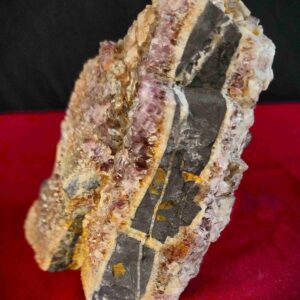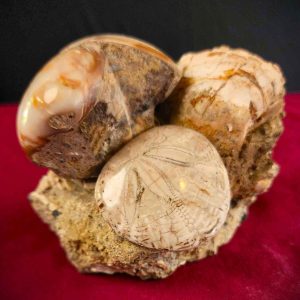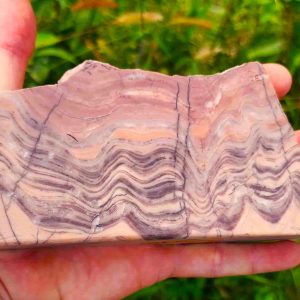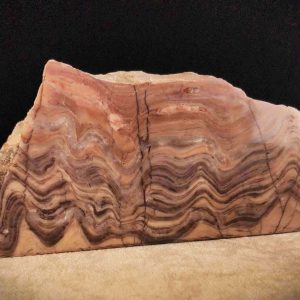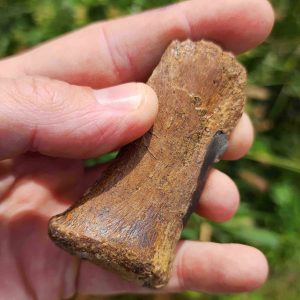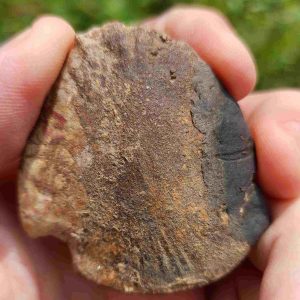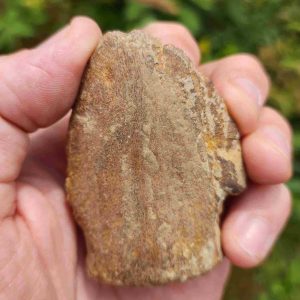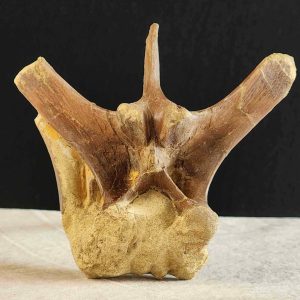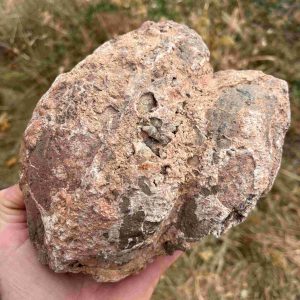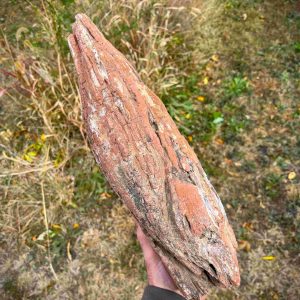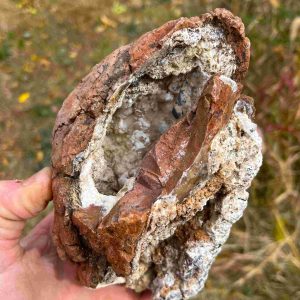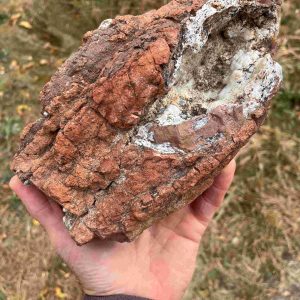-
Cerdito Prospect Rift Crystals (CP10)
Notes specific to this specimen: Both smokey quartz and amethyst crowded on the front face. Beautiful fracture infills showing on both sides. Also has a nice amethyst-lined hollow on the back with amethyst veins all over. This piece has a flat bottom so it stands up and displays very nicely. Take a look at the cut bottom and you’ll see the very graphic splitting of the matrix and the subsequent infilling. Fantastic piece!
SIZE: 5″ x 4″ x 6″
Quartz – Amethyst, Smokey, Citrine, Clear
AGE: Mesoproterozoic Era – 1.1 billion years
UNIT: Rove Formation
SITE: Thunder Bay, Ontario, Canada
DATE: 2022Documentation: This authentic mineral specimen comes with a Certificate of Authenticity and Origin.
$625.00 -
Fossil Sand Dollar and Clam (KH9)
Notes specific to this specimen: One large polished sand dollar with two great polished clams. Matrix piece that has a flat bottom so it stands nicely.
SIZE: 4″x 2″x 3″
NAME: Psuedocardium & Dendraster
AGE: Pliocene 4 million years
UNIT: Etchegoin Formation
SITE: Kettleman Hills, CaliforniaDocuments: This authentic fossil specimen comes with a Certificate of Authenticity and Origin. In addition, an attractive and informative display card accompanies the specimen.
$395.00 -
Kona Dolomite (KONA10)
Notes specific to this specimen: This is an excellent sliced section showing multiple stromatolite colonies with distinct layers (laminae). The clear layering is unusual for this slightly metamorphosed material. It has a smooth back and a flat bottom so it stands up nicely.
SIZE: 6″ x 3″ x 1″
NAME: Collenia kona
AGE: Paleoproterozoic Era 2.3 billion years
UNIT: Kona Formation
SITE: Kona Hills, Michigan
DATE: 2023Documentation: This authentic fossil specimen comes with a Certificate of Authenticity and Origin.
$185.00Kona Dolomite (KONA10)
$185.00 -
Kona Dolomite (KONA9)
Notes specific to this specimen: This is an excellent sliced section showing multiple stromatolite colonies with distinct layers (laminae). The clear layering is unusual for this slightly metamorphosed material. It has a smooth back and a flat bottom so it stands up nicely.
SIZE: 6″ x 3″ x 1″
NAME: Collenia kona
AGE: Paleoproterozoic Era 2.3 billion years
UNIT: Kona Formation
SITE: Kona Hills, Michigan
DATE: 2023Documentation: This authentic fossil specimen comes with a Certificate of Authenticity and Origin. In addition, an attractive and informative display card accompanies the specimen.
$245.00Kona Dolomite (KONA9)
$245.00 -
Dinosaur Bones (D4)
Notes specific to this specimen: This is a distal manus digit (“finger”) bone of Edmontosaurus. In vertebrates, the ends of the front appendages are called the “manus” (aka hand) while the back are called the “pes” (aka foot). The fine detail on the bone surface is remarkably well preserved. This piece has a small amount of reconstruction as shown in the dark paleoclay area.
SIZE: 3″ x 1″ x 1″
NAME: Edmontosaurus
AGE: Cretaceous Period – 68 million years
UNIT: Lance Creek Formation
SITE: Lance Creek, WyomingDATE: 1992
Documentation: This authentic fossil specimen comes with a Certificate of Authenticity and Origin.
$365.00Dinosaur Bones (D4)
$365.00 -
Dinosaur Bones (D3)
Notes specific to this specimen: Commonly called the “hoof” of a hadrosaur – in this case Edmontosaurus – this is the end bone of a pes digit (toe). In vertebrates, the ends of the front appendages are called the “manus” (aka hand) while the back are called the “pes” (aka foot). The fine detail on the bone surface is remarkably well preserved. This piece has a small amount of reconstruction as shown in the dark paleoclay area.
SIZE: 3″ x 2″ x 3″
NAME: Edmontosaurus
AGE: Cretaceous Period – 68 million years
UNIT: Lance Creek Formation
SITE: Lance Creek, WyomingDATE: 1992
Documentation: This authentic fossil specimen comes with a Certificate of Authenticity and Origin.
$420.00Dinosaur Bones (D3)
$420.00 -
Dinosaur Bones (D2)
Notes specific to this specimen: Commonly called the “hoof” of a hadrosaur – in this case Edmontosaurus – this is the end bone of a pes digit (toe). In vertebrates, the ends of the front appendages are called the “manus” (aka hand) while the back are called the “pes” (aka foot). The asymmetry here indicates this was likely a toe on the right side of the animal. The fine detail on the bone surface is exquisite and remarkably well preserved. This piece has no reconstruction.
SIZE: 3″ x 2″ x 1″
NAME: Edmontosaurus
AGE: Cretaceous Period – 68 million years
UNIT: Lance Creek Formation
SITE: Lance Creek, WyomingDATE: 1992
Documentation: This authentic fossil specimen comes with a Certificate of Authenticity and Origin.
$575.00Dinosaur Bones (D2)
$575.00 -
Dinosaur Bones (D1)
Notes specific to this specimen: This is a very well preserved neural arch and process of a cervical vertebrae, probably about midway down the neck of a hadrosaur (bipedal) dinosaur. The centrum is not present. The fine detail on the bone surface is exquisite and remarkably well preserved. This exceptional piece has no reconstruction.
SIZE: 5″ x 5″ x 3″
NAME: Edmontosaurus
AGE: Cretaceous Period – 68 million years
UNIT: Lance Creek Formation
SITE: Lance Creek, WyomingDATE: 1992
Documentation: This authentic fossil specimen comes with a Certificate of Authenticity and Origin.
$820.00Dinosaur Bones (D1)
$820.00 -
Volcanic Bomb (EB14)
Notes specific to this specimen: Rare double bomb. These unique specimens form when two magma projectiles run into each other in flight before they completely harden. In this case the merge was early in the ejection event, before the two projectiles had started to acquire their own individual character. Instead the combination of the two was almost obliterated by the overall form taking shape before they fell back to Earth.
SIZE: 9″ x 6″ x 4″
NAME: Various forms
AGE: Pliocene Epoch- 5 million years
UNIT: Banbury Formation
SITE: Elko County, NevadaDATE: 2020
Documentation: This authentic fossil specimen comes with a Certificate of Authenticity and Origin.
$695.00Volcanic Bomb (EB14)
$695.00 -
Volcanic Bomb (EB12)
Notes specific to this specimen: Large, rare, combination fusiform bomb. This is the result of three individual magma projectiles running into each other in flight. In this case the merge of these three individuals was early in the ejection event but after the individual projectiles had started acquiring their own individual character. The combination of these three bombs resulted in one very large cigar-shaped bomb which acquired it’s own form which dominated the final shape before falling back to Earth.
SIZE: 15″ x 6″ x 5″
NAME: Various forms
AGE: Pliocene Epoch- 5 million years
UNIT: Banbury Formation
SITE: Elko County, NevadaDATE: 2020
Documentation: This authentic fossil specimen comes with a Certificate of Authenticity and Origin.
$695.00Volcanic Bomb (EB12)
$695.00 -
Volcanic Bomb (EB6)
Notes specific to this specimen: Complex plump fusiform bomb with smooth aerodynamic striations. Apparently ran into another bomb during flight and part of that bomb is still attached but is not complete. Natural breaks reveal chalcedony interior which fluoresces a vibrant green. Unusual.
SIZE: 7″ x 4″ x 4″
NAME: Various forms
AGE: Pliocene Epoch- 5 million years
UNIT: Banbury Formation
SITE: Elko County, NevadaDATE: 2020
Documentation: This authentic fossil specimen comes with a Certificate of Authenticity and Origin.
$310.00Volcanic Bomb (EB6)
$310.00 -
Volcanic Bomb (EB4)
Notes specific to this specimen: Large classic plump fusiform bomb with great aerodynamic striations. It looks like it encountered another in flight but did not complete the merging with it. Natural breaks reveals chalcedony interior which fluoresces a vibrant green. A great specimen.
SIZE: 10″ x 5″ x 4″
NAME: Various forms
AGE: Pliocene Epoch- 5 million years
UNIT: Banbury Formation
SITE: Elko County, NevadaDATE: 2020
Documentation: This authentic fossil specimen comes with a Certificate of Authenticity and Origin.
$265.00Volcanic Bomb (EB4)
$265.00
Shop Our Catalog
- Browse All Products
- Agatized Algae
- Agatized Coral
- Cerdito Prospect Rift Crystals
- Rucks Pit
- Dinosaur Bones
- Exceptional Museum Specimens
- Fossil Echinoids
- Fossil Fern
- Gunflint Iron Rainbow Stromatolite
- Gypsum Selenite
- Iron Range Stromatolites
- Kettleman Hills Fossils
- Kona Dolomite
- Specularite
- Sudbury Impactite
- Volcanic Bombs

